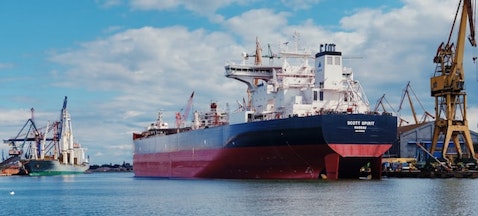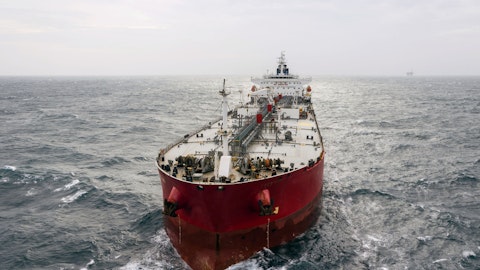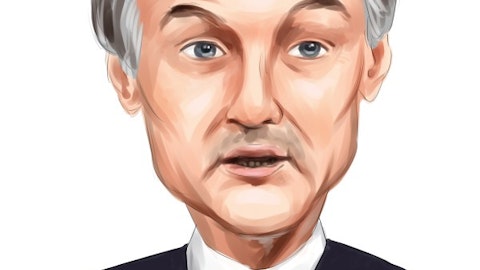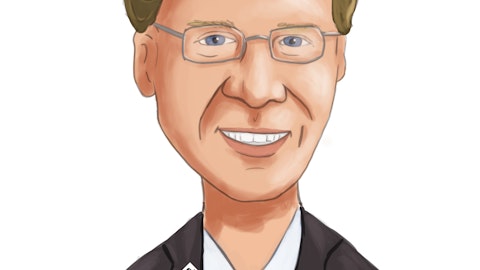Tsakos Energy Navigation Limited (NYSE:TNP) Q3 2022 Earnings Call Transcript November 22, 2022
Tsakos Energy Navigation Limited misses on earnings expectations. Reported EPS is $1.48 EPS, expectations were $2.19.
Operator: Thank you for standing by, ladies and gentlemen and welcome to the Tsakos Energy Navigation Conference Call on the Third Quarter 2022 Financial Results. We have with us Mr. Takis Arapoglou, Chairman of the Board; Mr. Nikolas Tsakos, President and CEO; Mr. Paul Durham, Chief Financial Officer; and Mr. George Saroglou, Chief Operating Officer of the company. And now, I pass the floor over to Mr. Nicolas Bornozis, Chief President of Capital Link Investor Relations Advisor to Tsakos Energy Navigation. Please go ahead, sir.
Nicolas Bornozis: Thank you very much and good morning to all of our participants. I am Nicolas Bornozis of Capital Link Investor Relations Advisor to Tsakos Energy Navigation. This morning, the company publicly released its financial results for the third quarter and 9 months ended September 30, 2022. In case you do not have a copy of today’s earnings release, please call us at 212-661-7566 or email us at ten@capitallink.com and we will have a copy for you e-mailed right away. Please note that parallel to today’s conference call, there is also a live audio and slide webcast, which can be accessed on the company’s website on the front page at www.tenn.gr. The conference call will follow the presentation slides. So please, we urge you to access the presentation slides on the company’s website.
Please note that the slides of the webcast presentation will be available and archived on the website of the company after the conference call. Also, please note that the slides of the webcast presentation are user controlled and that means that by clicking on the proper button you can move to the next or to the previous slide on your own. At this stage, I would like to read the Safe Harbor statement. This conference call and slide presentation of the webcast contains certain forward-looking statements within the meaning of the Safe Harbor provision of the Private Securities Litigation Reform Act of 1995. Investors are cautioned that such forward-looking statements involve risks and uncertainties which may affect TEN’s business prospects and results of operations.

Photo by Mateusz Suski on Unsplash
And before passing the floor to the Chairman, I would like to remind everybody and congratulate them. This year the company is celebrating its 20th anniversary of listening on the New York Stock Exchange, and on December 9, we look forward to having with us in New York the management of TEN and Dr. Tsakos of joining the Capital Link Invest in Greece Forum on December 9 in New York. And at this moment, I would like to pass the floor to Mr. Arapoglou, the Chairman of Tsakos Energy Navigation. Please go ahead, sir.
Takis Arapoglou: Thank you, Nicolas. Good morning, good afternoon to all. Thank you for joining our call today. Real congratulations to management for historical second best quarterly performance, just below the highest ever in Q4 07 of $52 million. So this is a great result. It proves once again the strategy TEN strategy model, protects us in bad times, fully response in good times and allows us to serve our obligations to pay dividends and generate cash for new business. And we are very happy that all this is reflected now is beginning to be reflected on the stock price. And in particular, I’d like to congratulate management for the successful new business with another blue chip customer, Total, on the first deal ever on very successful business. So without further ado, congratulations to Nikolas Tsakos and his team and offer the floor to him for the rest of the meeting. Thank you, Nikolas.
Nikolas Tsakos: Thank you, Chairman and good morning, good afternoon to all of you. Thank you for being here and supporting and following TEN’s 20-year performance on the New York Stock Exchange and at 30 years, next year, which is going to be our 30th year anniversary since the company was established on the Oslo Stock Exchange. So and hopefully, our share price will be above $30, we are hoping to be well above $20 in the remaining of the year. So, we worked on $10 or $20 in the next year, it’s going to be $10 or $30 at least, but thank you for bringing us where we are. As the Chairman said, this really was our best quarter in the last 15 years. We have not had such a high return in since the fourth quarter of 2007. So and but I believe that if things continue to go and you know I am very conservative usually but I hope that we will break the record, Paul.
Paul is working on it already and our chartering team at the same time in the fourth quarter of this year things look to be even stronger or rosier and this is a time that the TEN model proves it works, because we can work at difficult times, but also much better times. We have, as George Saroglou is going to point out, we have, this is our fifth crisis that we are coming out from, for the tanker market based on geopolitical events and market-related events and economic events and our aim is always to have a sustainable growth. We are able to fix business at the time and make sales of ships at the times at the high times that will carry us on to the next cycle. And I think this is the time we are doing. Now, we are enjoying 6-figure returns or revenue time charter revenues in a majority of our Aframax, Suezmax, and VLCC fleet which hopefully will be portrayed on the fourth and the first quarter.
And what gives me comfort is right now, we are in a situation where very little new building supply is coming in and so this good market perhaps not at these high levels as always, but it will be sustainable for at least the next 3 years. In TEN, we use the low markets to be able to purchase new modern assets as we have done and then charter them out when the times are better for long-term to be able to cover the cyclical markets that we might the cycle that the market might bring. And with this, I would like to ask George Saroglou not to take too much of his time to give us a little description of the last 9 months and focus on the subsequent events, which we will talk also after the during the question time.
George Saroglou: Thank you, Nikolas. Good morning to all of you joining our earnings call today. Let’s go to the slides of our presentation. Starting with Slide 3, we see that since TEN’s inception in 1993, we have faced five major crisis and each time, the company has come out stronger, thanks to its operating model. This time is no exception. We manage the COVID pandemic without any serious effects for both fleet and onshore operations and we are currently navigating the challenges created by the war in Ukraine. The market fundamentals, record low order book, and an aging fleet, even without the tragic war were positive for the tanker industry. The combination of self-imposed and mandated sanctions on Russian oil as a result of the war served as an additional catalyst to propel freight rates higher as long-established trade routes were disrupted and voyage distances lengthened.
A new round of European sanctions on oil imports from Russia is expected in December. The full impact cannot be assessed until details are known. However, it is expected to sustain the lengthening of voyage distances which coupled with normal winter factors like weather delays and an increase in oil demand due to gas-to-oil switching as a result of higher natural gas prices in Europe is expected to keep the freight rates in the tanker market serve through this winter and the months ahead. Russia will need to reroute its oil exports away from Europe. In Europe, we need to backfill those short coal imports from other more distance locations, both of which will continue to create significant ton-mile demand for tankers. With record low order book and the redesign of the global energy map for both crude and oil product trades, we expect the tanker industry to go through a sustained strong markets in the years to come.
In Slide 4, we see the fleet and its current fleet employment. 40 out of the 66 vessels or 61% of the fleet in the water has market exposure, a combination of spot contract of affreightment and time charters with profit sharing. 44 out of 66 vessels or 67% is in secured contracts fixed time charters and time charters with profit sharing. This means that TEN is well-positioned to capture the prevailing positive tanker fundamentals. And we have taken advantage of the good tanker market as our earnings release of today shows. Fleet was there, and it is a key element of our operating model. Year to date, we sold 2 vessels, 2003 built Panamax tanker and the 2006 built of our 2 Aframax tanker, and took delivery of 3 modern vessels. Two new buildings in January, we took delivery of LNG carrier TEN Energy and in July of the shuttle tanker quarter.
In this month, we took delivery of it to build eco-friendly scrubber fitted VLCC which we have renamed as DS1, the Greek name for . All 3 vessels are chartered against long accretive time Charters. In fact, today we announced the start of the three-year time charter with profit sharing for DS1 to a significant oil major. Asset prices continued to trend higher. Management is actively exploring opportunities to divest some of its earlier generation vessels and replace them with more modern eco-friendly greener vessels. On the newbuilding front, we announced today a project with a major energy concern to build and Time Charter up to 3 shuttle tankers against minimum 5-year up to 15-year contracts. This is in addition to a note that we have in place for 4 newbuilding Aframax tankers, which we expect to start taking delivery from the fourth quarter of 23.
And which are part of the company’s green ship dual fuel LNG powered initiatives. All vessels are coming with long-term employment attached. In Slide 5, we present the company’s current and long-term clients. As you see, we have a blue chip customer base, consisting of all major global energy companies, refineries, commodity traders with Equinor currently topping the list as our largest charter with 9 vessels and 4 new buildings all on long-term time charters. On Slide 6, the left side presents the all in breakeven cost for the various vessel types we operate. We maintain as you see a low-cost base. We have a simple operating model. We try to have our Time Charter vessels generate revenues that cover the company’s cost expenses, which means paying for the vessel operating expenses, finance expenses, overheads, chartering costs, and commissions and we will add the revenue from the spot trading fleet contribute to the profitability of the company.
Despite the prevailing inflationary pressures, we want to highlight the purchasing power of our technical managers and the continuous cost control efforts by management to maintain a low OpEx average for the fleet, while at the same time keeping a high fleet utilization and quarter-after-quarter, year after year. Despite 14 special surveys, some are ahead of schedule in preparation of the anticipation and the anticipated market upturn we achieved an OpEx overall utilization of 93.7% for the fleet. And thanks to the profit sharing element, for every $1,000 increase in spot rates, we have a positive $0.29 impact in annual EPS based on the number of vessels we currently operate in the spot market. Slide #7. Debt reduction is also integral to the company’s capital allocation strategy.
The company’s debt peaked in December 2016. Since then we have repaid $428 million of debt and we purchased $100 million in two series of step-up preferred shares we had outstanding. In addition to paying down debt, in Slide 8, we see that dividend continuity is important for common shareholders and management. TEN has always paid the dividend irrespective of the market cyclicality. $0.15 per common share will be paid in December 22 to shareholders of record on December 14. The December dividend payment represents a 50% increase from the July $0.10 a share dividend. The company has paid $0.5 billion in dividends since we listed the company in the New York Stock Exchange in 2002. Global oil demand continues to recover despite lockdowns in China as a result of the zero COVID policy and mounting global economic headwinds.
For the year, oil demand is expected to grow by 2.1 million barrels per day. Next year, we expect growth to be 1.6 million barrels per day. Developed economies lead oil demand growth in 2022. In 2023, oil demand expansion is forecasted to come from the non-OSB countries. On the supply side, we have the recent OPEC+ cuts, the sanctions and self-sanctions on Russian crudes and that will play out in 2023, and further releases currently from the OECD strategic petroleum reserves. Global oil stocks continue to fall and are currently below the 5-year average in the periods 2017-2021. Non-OPEC 2023 production is set to rise coming mainly from Brazil, USA, Vienna, Canada, Mexico, and Norway. As global oil demand recovers continues to grow. Let’s look at the forecast for the supply of tankers.
The order book starts stands at a little over 4% over the next 3 years, which is the lowest that it has been in more than 30 years. At the same time, a big part of the fleet is 32% is over 15 years and we have 8.3% that is currently over 20 years. So, these are very strong fundamentals and as the next slide shows the scrapping activity since 2018. We have upcoming regulations and industry with decarbonization initiatives and almost 9% of the fleet over 20 years. So we think that all of these factors point to a very balanced tanker supply market for a couple of years ahead. And with that, I will ask Paul to walk you through the financial highlights for the third quarter and the 9 months of the year. Paul?
See also 10 Best Uranium Stocks To Buy and 11 Best TaaS Stocks To Invest In.
Paul Durham: Thank you, George. This is rather going to be a sort of super numbers starting with net income of over $51 million fully realizing our expectations for a strong quarter. In this quarter our vessels reaped an extra $92 million revenue over the prior quarter three, resulting in a total revenue of $224 million, a 70% increase, mostly from spot earnings of $103 million as rates surged. In addition, our time charter vessels in quarter three, including $14 million profit share generated over $120 million covering most of our operational expenses. The inflow of cash in the third quarter from our operations resulted in EBITDA of over $100 million compared to just $20 million in the previous third quarter. While in the 9-month period, EBITDA totaled $236 million.
From the start of this year to the end of September, TEN’s revenue reached $590 million, while net income in the 9 months amounted to over $130 million with profit share of nearly $21 million. Average daily TCE exceeded $32,000. Thanks to market conditions that allowed our fleet to achieve almost maximum utilization of 94% despite five vessels completing dry-dock in quarter three. The significant cash flow generated in the recent 9-month period and the abundant cash reserves generated as a consequence has placed us in a very favorable position. We anticipate these reserves will provide us new opportunities, such as those created by the company over the past months, such as, in particular, the new LNG carrier, the shuttle tanker, and more recently the new VLCC.
These newly acquired vessels are already operating on accretive Time Charters and are expected to generate considerable revenue in their lifetime. These are the kinds of opportunities that we believe will continue to generate accretive returns and secure our cash flow and of course as George has mentioned to reduce our debt. George?
George Saroglou: Yes. Thank you, Paul. Reducing debt was always good and we’ve been doing it quite drastically. We’re not only reducing debt from the highs of 2016-2017 by close to $470 million. And then another $100 million of buying back our prep. So I think what we have accomplished is a bigger fleet, a much more modern fleet with much less obligations and we’ve been doing this through thick and thins through the good times, the bad times, perhaps we’re one of the few companies out there that we have never delayed or renegotiated any of our banking relationships. Instead, and this is why we have always been offered very good terms, very competitive terms in growing the business at difficult times. I mean, the picture that Paul and George are showing to us is a picture of a strong market, a sustainable market going forward.
This is what we want to do, but we always protect the company’s downside as we have done in the past and we may need to further decrease our debt and increase our dividends to the shareholders. And with that in mind, it seems that the best is yet to come at least for the foreseeable future. I expect that we’re happily there so I expect the fourth quarter to be there to be a record quarter with the numbers that we’re seeing today. I mean our spot from Axis many of them are above the $100,000 a day level together with our Suezmaxes which is significantly higher, we’re in the third quarter was, and for sure the first 9 months. And with that positive note, I would like to open the floor for any questions. Thank you.
Q&A Session
Follow Tsakos Energy Navigation Ltd (NYSE:TNP)
Follow Tsakos Energy Navigation Ltd (NYSE:TNP)
Operator: Thank you. Our first question comes from the line of Climent Molins with Value Investors Edge. Please proceed with your question.
Climent Molins: Good morning, gentlemen. Thank you for taking my questions. Given the improved outlook on the tanker sector, I wanted to delve a bit deeper into your capital allocation priorities. How do you plan on balancing shareholder returns be dividends, or share purchases, growth spending, and deleveraging?
Nikolas Tsakos: Yes. Well, as you know, we are a company in growth mode. And so we always want to come to have ample cash for growth. And again it’s not growth for growth, it’s growth for accretive transactions that will get our earnings that there are above the $3, $4 level per share, I mean. And then of course dividend is very important for us. We are big believers in rewarding our shareholders and the management is the largest shareholders here. To reward the management through dividends going forward. So protection of a strong balance sheet, which if you go back over the years, we always maintain a strong liquidity because the only time you actually appreciate your strong liquidity is required you do not have it and TEN has never been in this situation in 30 years, and increase in dividends.
Climent Molins: Alright. And regarding your financial position, are you comfortable with your current level of leverage or would you like to deleverage a bit, repurchasing prepared or repaying bank debt?
Nikolas Tsakos: Very good point. And as I said, I mean if you look on Slide 7, that was put up there in the presentation, we have done a dramatic deleveraging considering that in 2016 the company was did not have the quality of the fleet that we have today, or the valuation of the fleet and we are determined to do this. And according to Paul, I think, by 2024 we will be a significantly under the $1 billion in debt. Our aim is to be above $1 billion in market cap and significantly under $1 billion in debt. And I think this is something we are working on that and I think you brought a very good point out there. We have one of our briefers, which is due for repurchasing at par in the next 6 months and that would be something that we might be using our excess liquidity to do.
Climent Molins: Thank you, Nikolas. That’s helpful. I will pas it over. Thank you for taking my questions.
Nikolas Tsakos: Thank you.
Operator: It appears we have no further questions at this time. I would now like to turn the floor back over to management for closing comments.
Nikolas Tsakos: Well, thank you very much. And it’s good when the news are good, I think we will get less questions. And I think that’s understandable. Again, as I said, we are looking and I think this is the first time we feel significantly strong about that we’re looking at a sustainable positive future for the tanker and energy industries. We are proud to grow the business with first-class clients and relationships. We want to thank you for your support in that. We hope that our next our next announcement, which would be in the first quarter coming up for the fourth quarter and first full year results we will have even better news and better prospects. And looking forward, we will be visiting New York in the next couple of weeks.
Looking forward to meet many of you face to face and talk about the industry and the company. And I would like from all of us here to wish our American friends and everybody around the world, a Happy Thanksgiving and Happy peaceful, and with you and your family, and thank you very much.
Operator: Ladies and gentlemen, this does conclude today’s teleconference. You may disconnect your lines at this time. Thank you for your participation and have a wonderful day.
Nikolas Tsakos: Thank you.




